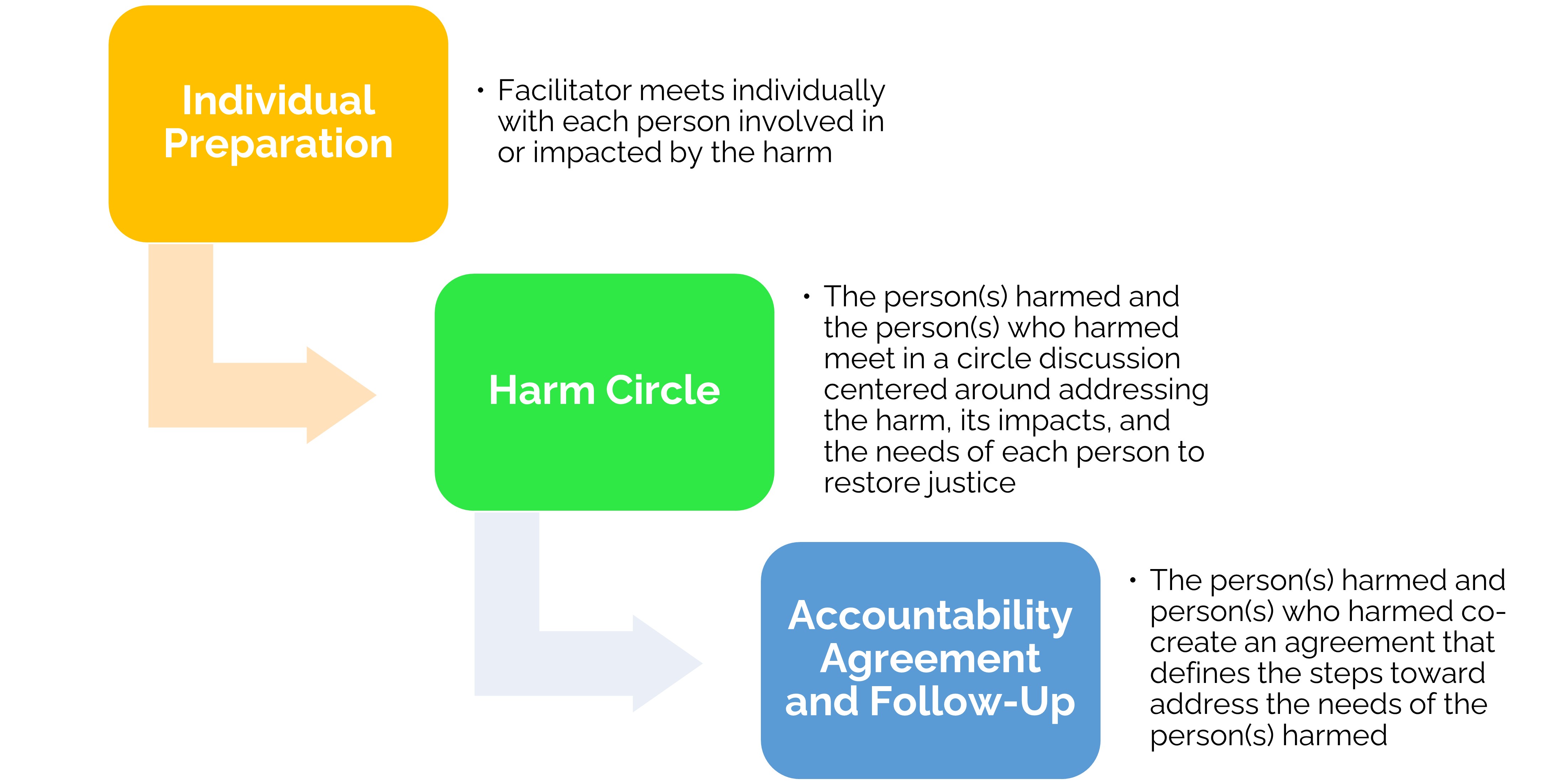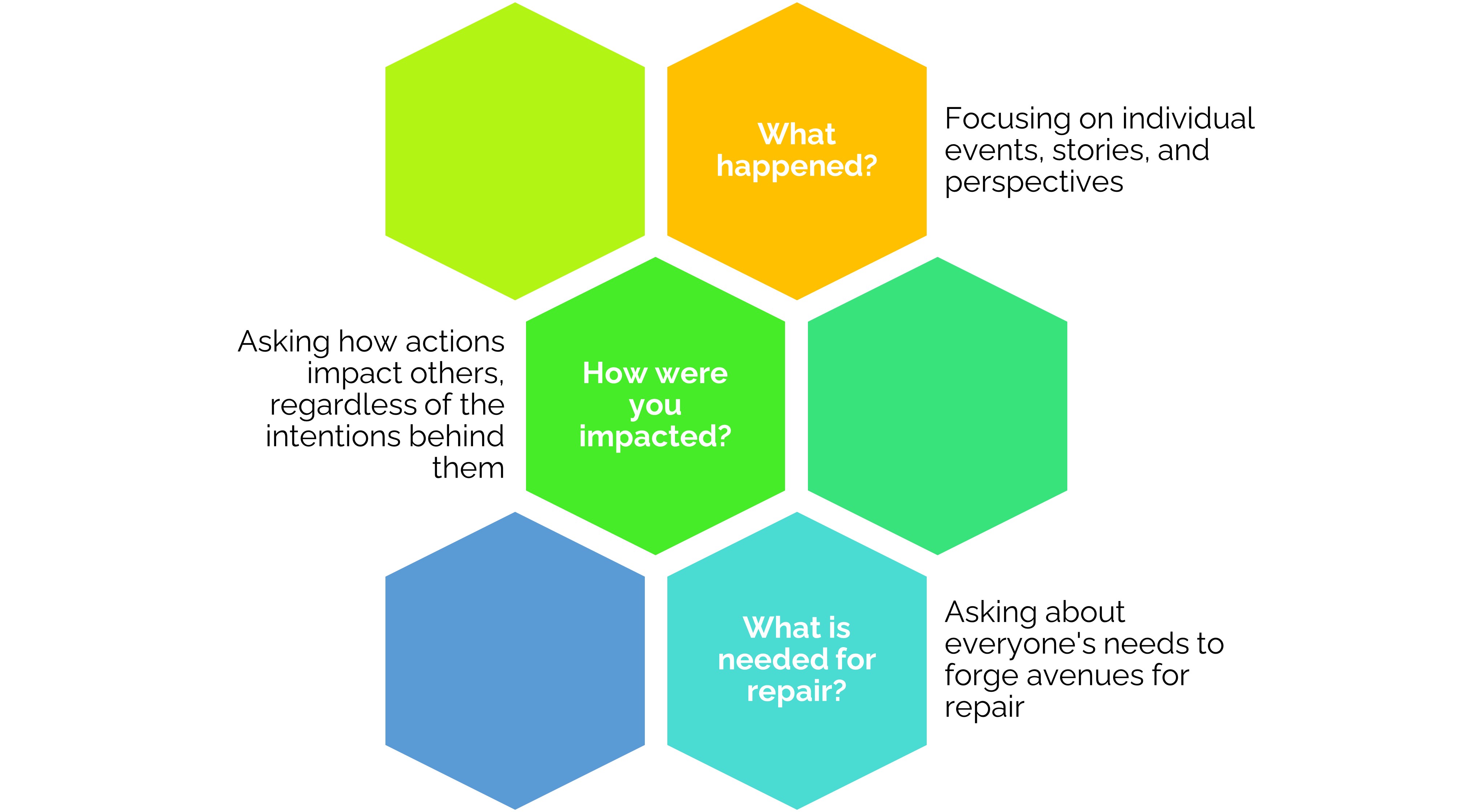Harm Process
The Restorative process to address Harm and hold harm circles
What are harm circles?
At their core, harm circles are spaces to identify harm and its impacts and take active steps toward repair by addressing the needs of those harmed, giving the person(s) who harmed an opportunity to take accountability for the harm they caused. The overall Harm Process involves elements outside of a specific Harm Circle, such as initial and follow-up conversations with facilitators. The harm process can be lengthy, and sometimes far from easy, but it has the potential to tangibly reduce the impacts of harm by opening avenues for healing and addressing individual and community levels of harm. Harm circles and processes are part of “Tier 2” Restorative Justice modalities.
An essential factor of Restorative Justice is separating individuals from their actions and asking what happened rather than what rules were broken, as a punitive approach might. In Restorative terminology, Harm is described as a violation of relationships, ranging from personal to professional to community relationships. Adding flexibility when defining harm allows facilitators and those who engage in Restorative Justice to think more deeply about adaptable and specific responses to harm. The multi-partial approach asks both the person harmed and the person who harmed what happened, and gives each the opportunity to share their perspectives to open up the conversation towards what is needed for repair. Focusing on relationships rather than rules also emphasizes how actions impact people.
Harm circles focus on the needs of the person(s) harmed to determine what is needed to make things right, or restore justice. Ensuring that the person(s) harmed is/are an active part of the resolution promotes a more perceptive approach to resolving conflict, giving those directly impacted a space to voice their experiences and needs. Making sure that the person(s) who harmed is/are an active part of the resolution gives them the opportunity to take accountability for the harm they caused and to reflect on their actions’ impact on others. The collaborative accountability process thus seeks to address the impacts of harm on others and explores intentional actions to remedy harm. This empowers change and promotes growth for both parties.
Restorative Justice views harm as both intensive and extensive, meaning that its impacts can be deep and affect multiple people at different levels, and is often referred to as a violation of relationships. In this light, we believe that many types of harm should be addressed by viewing its impacts beyond immediate individuals to the broader community. Harm processes and circles can sometimes involve community members that also felt impacted by an instance of harm.
Not all restorative processes will successfully resolve harm, but if both parties are willing to engage in this process, it is much more likely to have a collectively productive and positive outcome. We encourage you to try Restorative Justice if you feel as though the punitive system will not adequately address your needs, whether you have harmed someone, been harmed, or seen harm. All circle processes are a confidential space, and we won’t discuss what happens throughout the process with anyone outside of the circle context. If you wish to make an inquiry to start a Harm process, please fill out our google form or email us at restorativepractices@reed.edu.
What the Restorative Harm Process looks like
When harm occurs, a person who harmed, a person harmed, or a secondary affected party, will reach out to the Restorative Justice Coalition to ask for our help to facilitate a restorative process. While it is useful to have an agreement between all parties to go forward with the Restorative Process, it is not necessary, given we will meet with each party individually to get an initial understanding of the situation and verify all parties’ willingness to engage. The Restorative process is entirely voluntary, meaning that the person harmed must be eventually willing to take accountability for the harm they caused and the person harmed must feel comfortable going through a harm process as a method to address their needs for repair.
Facilitators will continue to meet with participants individually until they feel as though a harm circle will be a productive space for repair. The length of this phase will vary depending on the situation and participants, but it is vital for a truly restorative response.
If and when everyone feels ready to engage in a Harm circle, the facilitator will arrange a time and place where all participants can feel comfortable communicating and working through the circle components. The facilitator will begin with a check-in to establish the space, explain the role of the talking piece in directing the conversation, and then invite participants to create shared values that will underlie the circle. Once the circle space has been established according to the participants’ needs, the facilitator will begin by asking what happened, what were the impacts, to what extent the person who harmed is ready to take accountability, what the needs of the person harmed are, and other questions relevant to the individual case. Once each person has had the opportunity to present their perspectives and experiences, felt impacts, and their needs, the conversation will shift toward finding what is needed for repair.
Restorative Justice conversations around harm focus on active efforts to repair harm, part of which is reflected in an accountability agreement co-created by the person harmed and the person who harmed and other relevant parties. This agreement is focused on meeting the needs of the person harmed and allows the person who harmed to actively acknowledge and repair their impacts on others. The facilitator will support the person harmed and the person who harmed when creating the agreement if necessary, but will focus on ensuring that both parties engage in the process to truly promote active steps toward restorative justice. Both parties must agree to and sign off on the agreement. Facilitators will follow up with the person who harmed and the person harmed to provide any support needed to fulfill the accountability agreement.

When should I seek a Harm Process?
You should consider a Restorative Justice Harm Process when a punitive or judicial process does not fit your needs to resolve an instance of harm. This can mean many things, and be applicable in many cases. If you are the Person Harmed or the Person Who Harmed and wish to engage in an effort to collaboratively and actively work to resolve harm and/or repair relationships within a community, then a harm process would be a great opportunity to engage with harm to find a solution that fits the needs of all those involved. From minor disputes to disruptive harmful patterns, Restorative Justice can give you a voice and agency to repair harm, whether you were harmed or the person who harmed.
Harm circles actively involve all parties affected by instances of harm. Working through harm, its impacts, and resolutions demands work, but can also provide a way to truly address the root causes of harm by thinking about the context within which harm occurs. Facilitators will support those willing to engage with the restorative process, mindful of the experiences that may make parties reluctant to engage the harm itself.
The Restorative Justice Coalition upholds that the Harm Process is available to anyone that is open to it. It is a path towards repair that is inherently rooted in voluntary and meaningful participation, something which is subject to change at any point in time. Given the interaction between the various accountability groups at Reed, we understand that there might at any time be a transition to or away from a Restorative process, and want to support individuals should that be the case. For more information about the other accountability groups at Reed, we have collaboratively created an informative zine about how our processes differ and what each can do for the Reed community. All circle processes are a confidential space, and we won’t discuss what happens throughout the process with anyone outside of the circle context, even if a process transitions from one Group to another.
As of January 2024, the Restorative Justice Coalition cannot take on Title IX cases, and we recommend taking instances of harm involving sexual abuse and misconduct to SHARE.
